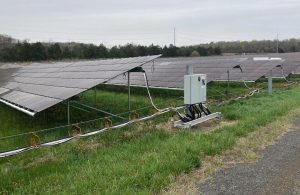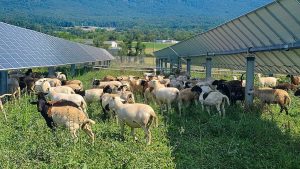Rain dripping off solar panels can produce a unique type of runoff — one the scientific community is playing catch-up to quantify as the solar industry rapidly expands its footprint in the Chesapeake Bay watershed.
Industry analysts predict that the nation’s solar market will triple over the next five years as it takes advantage of federal incentives. And data from the U.S. Department of Energy indicates that the U.S. will need to devote about 5 million acres of land to solar panels to meet renewable energy goals over the next 25 years.
Similar math is playing out in most of the Bay states as they work to meet their own renewable goals. Virginia has led the charge in rapid growth over the past five years, more than doubling the state’s footprint of solar arrays in that time, according to an analysis by the Chesapeake Conservancy.
The director of the Virginia’s Department of Environmental Quality, Mike Rolband, estimates that 317,000–687,000 acres of land will be converted to solar energy to produce 30–65 gigawatts of power by 2045. The variation depends on how many acres it takes to produce each gigawatt and the other sources of renewable energy that make up the state’s portfolio.
“We are talking about one of the largest land use changes ever in Virginia in a short period of time,” Rolband said during an April presentation to experts from both the stormwater and solar fields.
He made the comments during a workshop held by the Scientific and Technical Advisory Committee of the Chesapeake Bay Program, the state-federal partnership that leads the Bay restoration effort. The committee was discussing one of the region’s pressing issues: Could Bay states’ rush to increase solar energy get in the way of meeting water quality goals?
The crux of the problem, from a regulatory standpoint, lies with whether solar fields should be considered pervious or impervious land cover. Pervious areas allow water to soak into the ground. Impervious areas, like roads, rooftops and parking lots, do not. Polluted runoff from those hard surfaces causes problems for waterways across the Bay region — making them subject to regulation.
Utility-scale solar fields, also called “solar farms,” have both pervious and impervious elements: often enormous acreage covered by the panels and a range of soil conditions and groundcover below them.

The Remington Solar Power Facility on 125 acres in Fauquier County, VA, was developed as a public-private partnership between the state and Microsoft. (Meg Cole)
Many states consider solar fields pervious, which cuts regulatory red tape. Also, the volume and velocity of runoff from the panels falls somewhere between that caused by farmland and parking lots, depending on the type of groundcover under the panels. That makes solar facilities difficult to regulate under existing models.
But the sheer scale of the industry — and rapid rate of growth — has renewed the urgency to determine more precisely the relationship between solar panels and stormwater.
If calculating how much water runs off a solar panel sounds simple, it’s not. Similar to the dynamics on farmland, there are innumerable — and controversial — variables that can change the way rain runs off of panels and soaks into the ground (or doesn’t)。 Virginia DEQ formed an advisory panel in 2022 to determine, in response to legislation that required it, the stormwater impacts and appropriate mitigation options for replacing “prime” agricultural and forested land with solar panels.
“The workgroup developed 41 proposals but was unable to reach consensus,” Rolband said of the effort. “How do you balance the legitimate concerns of local governments and the companies?”
His department will have to attempt an answer to that question soon. Although the stakeholders couldn’t come to an agreement, legislation still requires DEQ to finalize new regulations for solar stormwater by the end of 2024.
Existing studies
The research community isn’t starting from scratch on the topic.
“There is a whole lot of science around stormwater regulation,” said Brian Ross, vice president of renewable energy for the Great Plains Institute for Sustainable Development, a Minnesota-based firm researching ways to improve renewable energy. Just “not for the kind of land use that is a ‘solar farm.’”
Foxhound solar flowers
Native flowers surround solar panels in Westmoreland County, VA. The project is part of Virginia’s voluntary Pollinator-Smart Program. (Virginia Department of Conservation & Recreation)

Researchers from Pennsylvania State University released a review in April 2022 of the existing science and legal frameworks for managing stormwater on solar farms. At the time, 12 states had solar-specific guidance for construction and post-construction stormwater management, said Lauren McPhillips, an assistant professor at Penn State who oversaw the research. The rest did not.
“Some states don’t treat solar farms as impervious surface, but quite a few are moving toward trying to consider [solar panels] as ‘disconnected’ impervious surface,” McPhillips said at the Scientific and Technical Advisory Committee meeting in April.
Maryland and Pennsylvaniahave policies that either consider the panels pervious, under most conditions, or exempt them from being considered impervious for the purpose of stormwater management. Virginia had a similar approach — until Rolband announced in March 2022 that solar projects in the state would be subject to stronger post-development stormwater regulations. Initially, the policy was “effective immediately,” but strong industry pushback caused the department to extend the timeline for research and implementation.
Rolband said in April that Virginia DEQ recently gave a $3.4 million grant to state universities to spend six years “actually measuring” how stormwater runs off solar panels at a variety of sites in the state. Dominion Power has also helped fund the research, he said.
“We want to get some science in here and then obviously use that to calibrate the models,” Rolband said.
Bay restoration organizations are also studying the broader impact of solar installations on land use in the region. Most notably, the nonprofit Chesapeake Conservancy recently applied its artificial intelligence technology to predict where solar facilities might be in the future based on where it has been growing in recent years.
Michael Evans, a senior data scientist with the conservancy’s Conservation Innovation Center, said an analysis of trends from 2017 to 2021 showed that the majority of land being converted to solar uses was cropland and pasture. That’s a trend some agriculture advocates have found troubling, but Evans found it “encouraging, from a biodiversity, ecosystem-services” perspective.
“By and large, the solar growth we’ve seen so far has been avoiding natural landscapes and going for croplands,” he said. “Not only was agriculture being converted to solar, but there is evidence that the least suitable agricultural lands are being converted first.”
Evans said one possible reason is that the farmers and solar companies are looking for similar sites: land that is relatively flat, gets good sunlight and is near transportation networks.
Still, solar’s future footprint could be difficult to predict. David Murray, director of solar policy at American Clean Power, said the selection of solar sites is based on a complex combination of variables. At the top of that list is access to high-voltage transmission lines and the cost of connecting to the existing grid. After that is finding locations that avoid sensitive habitats and where landowners and local zoning laws are open to solar projects.

Sheep feed from a mix of plants growing at the Nittany 1 solar array in central Pennsylvania. The plants were selected to support the sheep’s nutritional needs and attract pollinating insects. (Lightsource BP)
“Honestly, Congress can do all they want to incentivize clean energy. But, at the end of the day, whether solar is going to be successful is up to every county and town in the country,” Murray said. “A number of times, a developer will get a report back that says it’s infeasible economically.”
Inconsistent practices
But, as with active farmland, not all acres of solar panels are managed equally. While the industry and regulators have a suite of best practices that can reduce stormwater runoff from solar panels, they can be costly and are not deployed consistently.
Andrew Foley, a water program specialist with Pennsylvania’s Department of Environmental Protection, said his agency is in many ways trying to catch up to the solar developers with regulations that keep their operations, which are largely permitted at the county level, from contributing excess runoff.
“The biggest issue is consistency,” he said.
Even when regulations are in place, compliance on sites under construction can be a problem. Virginia’s DEQ regulates the largest solar facilities while counties tend to oversee others. Of the 77 that DEQ was overseeing in April, Rolband said nearly 70% of them had “significant issues” complying with stormwater regulations. About 30% of the violations were pending or had consent orders — agreements that dictate how a site must get back into compliance.
“What we’re seeing on the ground is huge problems, due mostly to lack of any vegetation,” Rolband said.
At solar installations where heavy machinery is used to grade the landscape, soil compaction is the biggest problem. And it’s not easy to fix afterwards, because the compaction makes it difficult to grow plants that keep soil in place long-term. One study found that a landscape compacted by solar installations remained so, in some cases 10 years after the panels were removed and the land was replanted. Many solar farms are installed under 25– or 30-year leases with an understanding that the land could be used for agriculture again once it expires.
“If you drive a piece of equipment over the soil, it’s compacted. Then you need to restore the soil,” said Stewart Comstock, chief of the program review division of the Maryland Department of the Environment’s stormwater program.
The solar industry knows about these issues and points to pioneering projects that plant native meadows and deep-rooted grasses before solar panels are installed or use sheep instead of machinery to manage grass growth. Changing the way things are done can be difficult, especially in periods of rapid development. But a recent slowdown in solar approvals, along with regulatory changes on the horizon, could set the stage for new practices.
“Unlike a lot of other industries I’ve worked in where you can do remediation afterward, [with solar] we really need to put all of that at the beginning,” said Virginia Brown, director of ecosystem services for solar developer Lightsource BP, during the Scientific and Technical Advisory Committee workshop. “The timeline of construction is very tight, but … we always have to think about vegetation.”
Peter Claggett, a U.S. Geological Survey geographer who coordinates the Bay Program’s Land Use Workgroup, said his biggest takeaway from the workshop was that, when it comes to managing stormwater on solar farms, site preparation and revegetation may be more important than how the panels are arranged.
The Chesapeake Conservancy has shared its solar land use data with the Bay Program to help inform land use cover data for future computer modeling.






